Telangana SCERT 8th Class Social Study Material Telangana Pdf 5th Lesson Forests: Using and Protecting Textbook Questions and Answers.
TS 8th Class Social 5th Lesson Questions and Answers – Forests: Using and Protecting
Improve Your Learning
Question 1.
Do you agree with the following statements? Give reasons for your agreement or disagreement. (Conceptual understanding)
i) The notion of private property is important to protect the forest.
Answer:
- For thousands of years tribal people have lived in the forests, protected them and earned their livelihood from them.
- In the days before the British rule, the tribal people treated the forests as their own. They used it without causing damage and took care to ensure the regeneration of trees.
- During the last 200 years tribals were rendered homeless in their own homes which lead to degraded forest land.
- Forest Rights Act, 2006 confers on forest dwellers their traditional users of forests, their rights over the forests to save the forests.
ii) All forests need to be protected by human beings.
Answer:
We need to protect our forests because,
- Environmental destruction results in poverty in the communities that are directly dependent upon forest and wildlife.
- Conservation preserves the ecological diversity.
- It aLso preserves the genetic diversity of plants and animals.
iii) Over the centuries most people living on earth have reduced their dependence on forest for their livelihood.
Answer:
1. During the last two hundred ‘ears, the tribal people gradually lost their control and rights over the forest. It is due to great demand for wood and to raise plantation crops. It lead to degraded forest land.
2. Large-scale evictions of 1920, mopping operations till 1940 made tribals to adapt settled agriculture, modem education, and other works.
Question 2.
Create a timeline to show the major changes In use of forest over centuries. It may be required to look at your textbooks from previous classes. (Information skills)
| Event | Changes affecting tribal life | Impact on forest |
| Emergence of agriculture | ||
| Arrival of the colonial rulers | ||
| Government rules |
Answer:
| Event | Changes affecting tribal life | Impact of forest |
| Emergence of agriculture |
Human beings took to agriculture, plantations, industries. | Forests were confined to only tracts that were not useful for agriculture. |
| Arrival of the colonial rulers: 1864 and 1878 laws gave control over forests to forest department. | British exploited the hapless tribal people cheated them and constantly harassed them. Tribals lost their traditional customary rights over forest land. | Colonial forest policies led to depletion of forest resources. Forests were classified into reserved and protected forests, |
| Government rules: National Forest Policy-1988, Joint Forest Management, Forests Rights Act, 2006. |
Tribals are ensured livelihood and food security. The primary task is associated the tribes in the protection, regeneration, and developments of forests. | The act confers traditional rights of tribals, who are the main protectors and save the forests better. |
Question 3.
Based on the details given in the above text, or from what you already know about the forests, compare the type of forest that is closest to your area of living on the following aspects: (Reflection an contemporary issues and questioning)
| Density of trees | Types of trees found | Special features of trees |
Answer:
| Density of trees | Types of trees found | Special features of trees |
| Dense forests: Which receive more rainfalls, extended in North Eastern parts of Adilabad, Warangal & Khanimam | Vegi,Agesia,Maddi,Bhandaru etc. | Two types – moist and dry. |
| Less dense forests: Which receive less rainfall. Extended in Adilabad, Warangal, Karimnagar, Khammam and Nizamabad. |
Velaga, Yepi Neem, Buruga,Maddi, Teak | Sheds leaves for 6 to 8 weeks Every species has its own shedding time. |
Question 4.
Observe the map of forests in Telangana and find out which district(s) has/have the maximum forest-covered area. (Mapping Skills)
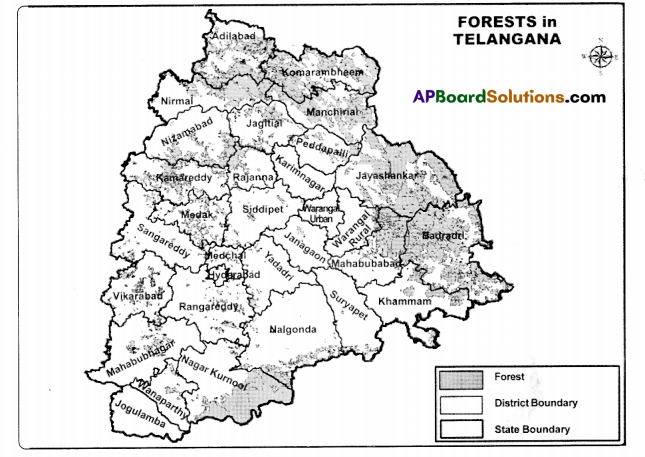
Answer:
In Telangana Badradri has the maximum forest covered area. Next to it are Adilabad, Nizamabad, Karimnagar, Mahaboobnagar, Komararn Bheem. Mancherial, Jagtiyal, Kamareddy, Medak and Nagarkurnool.
![]()
Question 5.
A few children in a school participated in Vanamahothsa warn programme and they planted some saplings. How would you respond to this? (Appreciation and Sensitivity)
Answer:
- I was inspired by the school children’s message to all that free protection is very important in environmental protection.
- I also want to participate in such programmes in the best interests of the society.
- I would like to create more awareness and encourage others to volunteer for the cause of greenery and environmental protection.
Question 6.
Read the paragraph under the Heading Furests of Telangana and answer the question:
(Reading flic text (given), understanding and interpretation)
What suggestions do you have for increasing the forest cover in our state?
About 26,904 kilometers of the slate an declared as forest hi the government This about 24% of all land in the state or nearly one-quarter of our state. However, all this is not really forested as only about 16.74% of our land has tree cover to qualify as forest. ‘This means that is about 7% of our forest lands are open grounds and with very fore trees. Even this forest cover is dwindling due to foiling, encroachment, mining, etc. Every year about thirty sq kilometers of forest are lost in our state.
Answer:
I suggest the following for increasing the forest cover in our state.
- Trees are good means to protect environment. So, free – planting in vacant lands in cities and in the surroundings of industrial institutions has gained momentum to check environmental pollution.
- In order to meet the needs of the rural population. trees are being planted in fallow and barren lands for firewood, animal feed, and timber.
- By experimentation, scientific research, such varieties of trees should be developed which can easily be grown in dry and hilly areas and wastelands.
- Some alternate materials should be used in place of wood such as plastic so that the need of wood is minimized. It reduces the pressure on forests.
Question 7.
What are the differences between Evergreen forests and Deciduous forests. (Conceptual understanding)
Answer:
| Evergreen forests, | Deciduous forests |
| These are called tropical rainforests Trees shed their leaves in the dry season to conserve water. | These are called monsoonal forests Trees do not shed their leaves all together. |
| Hardwood, trees like Rosewood, Ebony, Mahagony are common trees. | The hardwood trees are found here. They are Sal, Teak, Neem and Shishan. |
Question 8.
Observe the pictures on page 59 and write a comment. (Reading the text (give.:), understanding and interpretation)
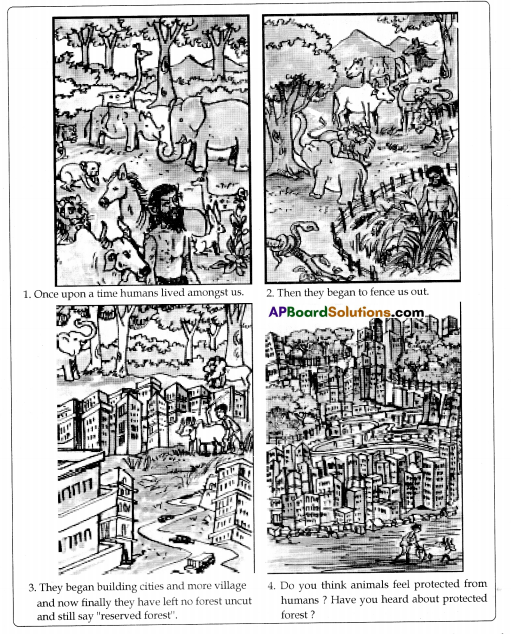
Answer:
Forests are the temples of trees and animals. The trees in the forests balance the climate by cooling it and absorbing carbon dioxide They help to maintain ecological balance with the greedy nature of man, slowly forests disappeared, and with it beautiful animals and birds.
Now the total earth became a concrete jungle with huge buildings, slowly, now the humans understood the importance of forests. Some areas are declared as reserved forests and protected forests to again grow more forests.
Intext Questions
Question 1.
Some of you may be familiar with a nearby forest – its trees, plants, animals, rocks, streams, birds, and insects. Describe to the class the forest in detail and what you do
there. (information skills)
Answer:
We had been to Urna Maheswaram in Mahaboobnagar district to visit our uncle. He took us to forest area. It is a dry deciduous forest area. We saw variety of trees like Maddi, Teak, Neem, Buruga. Moduga. I saw some deer running in the forest.
I saw a variety of birds and insects also. Small streams were flowing here and there. As the forest was not very dense! could run about and play. I tried rock climbing. I collected some forest products like leaves, seeds to show to my friends, It was a very memorable trip.
Question 2.
Have you ever been to a forest to collect firewood, leaves or fruits arid tubers? Tell everyone in the class about it and also make a list of all the things people in your area collect from the forests. How are they used? (information skills)
Answer:
Wood – Building cottages and making agriculture! tools, fuel. Plants like
Sarpagandha, seem – Medicines.
Mahua, Kadamba trees – For worship.
Forest products such as harks, leaves, rubber, dyes, food, fuel, fodder are used.
![]()
Question 3.
You have read about forests and people living in the forests in the previous classes. Can you recall Sonic of them and talk about people who live in the forests? (C.U.)
Answer:
- In Penugolu, Kevas live in very small habitation. they grow crop in a way called Podu.
- They build watch towers and guard the field from wild animals and birds till the harvest is over.
- The principal crops raised by Koyas are jowar. maize, tubers, and pulses.
- Koyas worship gods of nature and every family has got their kula devatha.
Question 4.
Can each of you draw a picture of a forest and compare them?
Answer:
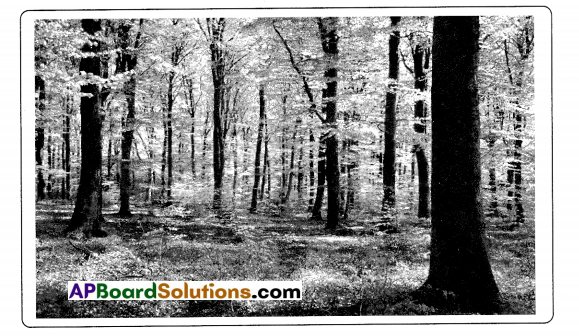
- Forests have variety of trees.
- A number of animals and birds are seen in forests.
- Forests are green in colour with colourful flowers, they are beautiful.
- Small streams, rocks are seen here and there.
Question 5.
Our folk tales and Puranas and stories repeatedly mention forests. Can you relate in the class some such stories about forests? (Information skills)
Answer:
The blue jackal – From Panchatantra
Long time ago there lived a jackal who strayed into a city in search of food. He was hungry and was being chased by a group of dogs. He accidentally entered the house of a dyer and fell into a drum of Indigo (blue) dye, and was stained blue from head to toe. When he escaped from the house back into the forest, all animals were surprised at his appearance and could not place its identity.
Taking advantage of the situation, the jackal decided to play the situation to his advantage. He proclaimed that he was a fierce owl, sent by the king of gods, Indra, to Earth to guard the forest.
Animals believe the ¡ackal. The jackal then appointed the lion as his Prime Minister, tiger as his guardian of the bed chamber, and the elephant was made the doorkeeper. He then drove all the ¡ackals out of sight from the forest for fear of being recognised, The animals would hunt fool and bring it to the self-proclaimed King, and the King would distribute the food to all equally just as a King would do. So he was leading a life of luxury.
One day a herd of jackals were passing by howling to their glory. Unable to control his natural instinct, the jackal showed his natural voice and howled at the top of his voice. Hearing this howl, the animals realised that they have been fooled by a jackal and killed the jackal instantly.
Story moral: Destiny can not be changed.
Question 6.
Many forests are sacred and are worshipped by the people. Some forests are famous as the abode of some gods and goddesses. Find out about them and tell everyone in the class about them. (Information skills)
Answer:
Nature worship is an age-old tribal belief. Such beliefs have preserved several forests in the form called sacred groves (the forests of gods and goddesses). Certain societies have a particular tree to worship-
- The Mundas and the Santhals of Chota Nagpur region, worship Mahua and Kadamba trees.
- Tribals of Odissa and Billiard worship the tamarind and mango trees.
- Many of us consider peepal and ban an tree as sacred.
- The Koya they consider the forest area of Medaram as the abode of gods and goddesses and celebrate jataka of Sammakka Sarakka.
- The Chenchus consider Srisailam forests as the abode of Lord Shiva.
Text Book Page No. 50
Question 7.
What is a forest There can be many ways of defining a forest. Write a definition of forests. (Conceptual understanding)
Answer:
Forest is a large area covered chiefly with trees and undergrowth. Forest is best defined as an ecosystem or assemblage of ecosystems dominated by trees and other woody vegetation. Forest is a large area made up of various species of plants and fauna.
Question 8.
Then discuss jointly in the class and write down points which seem to be correct to most students.
Answer:
Forest is a large area which contains various trees, shrubs, ferns, fungi. insects, small mammals etc.
Question 9.
Write a caption on the cartoon in the ccTSBoardSolutjons.jn
Answer:
Caytien –
Our life game on the earth should not be lifeless.
Save forests. They save you, Live and let live.

In the game of chess, the opposite forces try to kill each other and thus to win the game. Sometimes, by the end of the game, none remains. If humans go on killing the animals trespassing the forests which are animals’ kingdoms, no animal remains and it leads to eventual disappearance of human beings also from this planet earth.
![]()
Text Book Page No. 51
Question 10.
Do you think it is important to have forests’ What will happen if all the forests are cleared and used up for growing crops, building factories or mines or houses for
people to live? Cant we live without forests? Discus in your class. (Reflection on contemporary issues and questioning)
Answer:
We can’t live without forests because
- Forests maintain the ecological balance by absorbing carbon dioxide.
- They check on the rise of atmospheric temperature.
- Provide natural habitat to wildlife.
- Forests help in rainfall.
- Forests play a vital role in conservation of soil.
Question 11.
Which is the nearest forest area from your village or town? Find out why this area still has tree cover and has not been converted into fields or habitation or mines. (Reflection on contemporary issues and questioning)
Answer:
Nallamala forest is near to our town. The Community Forest Programme (CFM) helped to bring together the forest department and the local communities. They are saving the forests as protectors.
Text Book Page No.54
Question 12.
Find out how the mangrove trees adapt to the special conditions of sea coasts. (C.U)
Answer:
A Mangrove is a tropical maritime tree or shrub. Mangrove tree has special aerial roots and salt-filtering tap roots that enable them to thrive in brackish water.
Question 13.
You may remember reading about Equatorial forests in Africa. What are the main differences between the forests of Telangana and the Equatorial forests? (C.U.)
Answer:
| Evergreen forests | Deciduous forests | |
| Rainfall | More than 200 cm. | 20 to 70cm. |
| Height of trees | 60 m. | 40-50 m. |
| Shedding of leaves | No definite time of shedding. | 6-8 weeks in dry summer. |
| Important trees | rubber, rosewood, etc. | Teak, Sal, etc. |
| Common animals | Elephants, monkeys, etc. | Lion, tiger, etc. |
Question 14.
look at the map of Telangana given, showing the distribution of forests. Find out if your district has any forest and if yes, what kind of forest? (Information skills)
Answer:
This is a student’s activity.
For eg. Our district is Adilabad. We have wet deciduous forests.
Question 15.
Is this (status of forests in T.S) a satisfactory situation? Discuss in your class.
Answer:
No. The forest coverage is not satisfactory. The average land under the coverage of forests is to 24%, So, area under forest land needs to be increased through afforestation. scientific forestry etc.
![]()
Text Book Page No.56
Question 16.
Do you think it is possible for people to take care of forests and use them as well? What would they have done if someone had tempted them to cut trees and sell them in the markets? (Reflection on contemporary issues and questioning)
Answer:
Yes, it is possible for people to take care of forests and use them as well.
- For thousands of years tribal people have lived in the forests, protected them, and earned their livelihood from them.
- The tribal people treated forests as their own.
- The tribal people fought against, if someone had tempted them to cut trees and sell them.
- They protested against the evil practice. In some regions, they were able to win some protection from the government.
Question 17.
Do you think there is any difference between a plantation of eucalyptus trees or tea shrubs and a forest? Discuss in the class. (Reflection on contemporary issues and questioning)
Answer:
- A plantation contains a single crop which is harvested te be marketed often in distant markets, whereas a forest has a more complex structure than a plantation, being made up of various species of plants and fauna.
- A forest contains various trees, shrubs, ferns, fungi, small mammals etc, while a plantation would be void of these, with the exception of intentional additions that help protect the crops.
- Plantation crop- Tea, Rubber.
Forest- Evergreen, deciduous.
Text Book Page No. 57
Question 18.
List all the causes for the decline of forests in the last 200 years. Do you think Podu cultivation was also responsible for thist Give your arguments? (Reflection on contemporary issues and questioning)
Answer:
The reasons for decline of the forest are,
- There was a great demand for wood for various purposes like building railways, ships, mines, furniture etc. Forests were cut for wood pulp and to create plantations.
- Large-scale evictions that occured in 1920s and mopping operations continued till 1940.
- Podu cultivation was also responsible to a little extent.
Question 19.
What was the difference between protection of forests by the tribal people and by the Forest Department (Conceptual understanding)
Answer:
1. Tribal people used forests without causing damage to it. When they cleared forests they took care to ensure the regeneration of trees. They both cared for and used the forests just as a peasant family takes care of its firms.
2. Forest department had the responsibility of ‘harvesting of the forest’ that is felling nature old trees and selling them to earn money for the government. They exploited tribal people. This created insecurity among tribals under National Forest Policy 1988 an active cooperation between village communities and the forest department for the development of degraded forests began.
3. Forest department takes the protection of forests as their duty only but the tribals take it as a responsibility.
Question 20.
Why do you think were the tribal people unable to pay the land revenue demanded by the government? (Conceptual understanding)
Answer:
Tribals were made to pay high revenue. Often they had to borrow money from moneylenders to pay the amount. In the end, they had to sell off their lands to the moneylenders. Thus they again lost whatever land they had further leading to poverty.
Question 21.
Which way would have been better according to you? Discuss with your classmates. (Conceptual understanding)
Answer:
It is better to make them adopt settled agriculture modern education and industrial work.
Question 22.
Find out from your elders about their experience of CFM and also Social Forestry Projects. (information skills)
Answer:
CFM (Community Forest Management) helped to bring together the forest department and local communities. It forced tribal people to give up their Podu lands for forest regeneration. Several tiger sanctuaries were established to protect wildlife.
Question 23.
Why do you think did the government think that forest was not important for tribal people’s development?(Reflections on contemporary issues and questioning)
Answer:
Government forced the tribal people to give up their Podu lands for forest regeneration.
Tribal people can develop b’ adopting settled agricultures modern education and industrial work.
![]()
Text Book Page No. 60
Question 24.
In what way do you think does this act makes up for the injustice done to the tribal people in the past 200 years (Conceptual understanding)
Answer:
Forest Rights Act, 200b confers on forest dwellers and other traditional users of forests; their traditional rights over the forests, and also title to lands they’ use. If implemented properly, this act can be used to undo the wrong done to the tribal people over the generations.
Question 25.
Discuss this in the class- do you think it is the correct way to redress the wrongs done to the tribal people? How will it help in protecting the forests? What other steps need to be taken for this? (Appreciation and Sensitivity)
Answer:
1. It is the correct way to redress the wrongs done to the tribal people. By making the forest dwellers who have been traditionally taking care of the forests the main protectors, forests can be saved in a better way.
2. It is necessary to address the long-standing insecurity of land rights and access rights of forest dwellers including those who were forced to relocate their dwellings due to the construction of 1m or tiger reserve.
Reflection on contemporary issues and questioning
Q. How is the implementation of Forest Laws in your area? Though the Laws are in
vogue, the forests are disappearing day by day. What might be the reasons?
Answer:
The implementation of Forest Laws in our area is not satisfactory.
The reasons for the disappearing of forests though the laws are in vogue are:
- There is no sufficient staff with good weapons to protect the forests, The smugglers are even attacking the forest personnel sometimes. Sufficient staff are needed to check the wood smuggling.
- The growing of new plants is not in the same phase and speed as the trees that are cut off.
- The fire accidents that are taking place is also one of the reasons.
- The use of forests for commercial purposes rather than traditional domestic purposes is also one of the reasons.
- Lack of coordination, dedication to maintain forests, lack of understanding of the laws are also some of the reasons.
A) People of Penngolu Hills use the forests around them for poilu cultivation, collection of forest produce like food items such as fruits, tubers, etc., for sale like beedi leaves, medicinal plants, bamboo, tamarind, etc.’
Read the above paragraph “People of Penugolu …………… tamarind etc. and answer the following question.
1. How do the tribal people use the forests?
Answer:
The tribal people treated the forests as their own. But it was a sacred land to them, which they used without coursing damage to it or the animals in it. Even when they hunted animals or cleared forests for podu fields, They took care to ensure the regent ration of animals and trees.
B) “The tribal people had been protesting and fighting against these process. their cause was taken up by many non – government agencies which built a national campaign for tribal rights over forest. After prolonged debate tire parliament passed the Forest Rights Act in 2006″
Read the above passage “The tribal people …………….. Act in 2006” and answer the
following question.
Question 1.
What is the main reason for passing this Forest Rights Act, 2006 t
Answer:
To conserve the forests and at the same time ensuring livelihood and food security of the forest dwellers.
Information Skills
A.
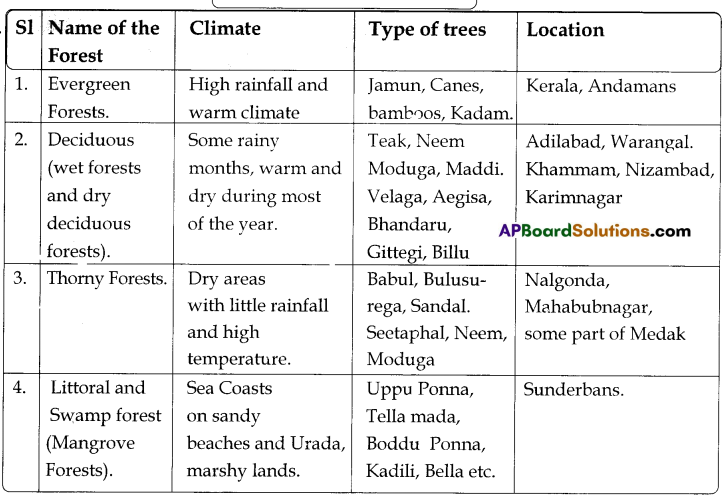
Read the above table and answer the following questions.
1. In which climatic regions evergreen forests grow?
Answer:
Regions which get very high rainfall and have warm climates.
2. Give some examples for thorny forests?
Answer:
Babul, Bulusurega, Sandal, Neem.
3. What are the two types of deciduous forests?
Answer:
Wet deciduous and dr’ deciduous forests.
![]()
4. Swamp forests are also called as what?
Answer:
Mangrove forests.
B. Thorny Forests:
These grow in very dry areas with little rainfall and high temperatures. Most of the trees are thorny The common trees are Babul (Thumina), Bulusurega, Seethapal, Moduga, Neem etc. In Telangana, they are found in Nalgonda and Mahaboobnagar and some parts of Medak District.
You may recall that these are the districts with very little rainfall nearing desert conditions. Thorny trees have very tiny leaves and thorns which help to conserve water. The forests are also not dense and have open spaces and more undergrowth with fewer trees.
Read the above passage and answer the following questions:
1. Where were the thorny forests in Telangana?
Answer:
Mahaboobnagar and Nalgonda districts.
2. Which type of trees grow in Thorny forests?
Answer:
Babul, Bulusurega, Seethapal, Moduga and Neem.
3. In which climate Thorny forests grow?
Answer:
These forests grow in very dry areas with little rainfall and high temperature.
4. What do you know about Thorny trees?
Answer:
Thorny trees have very tiny leaves and thorns which help to conserve water.
Mapping Skills
Question 1.
Locate and label some areas of forests in the given Telangana map.
Answer:
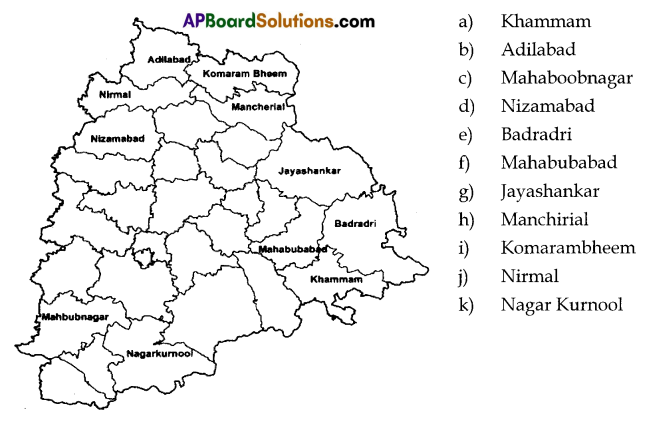
Question 2.
Point out the places of Evergreen Forests in India map.
Answer:
i) Kerala
ii) Andamans
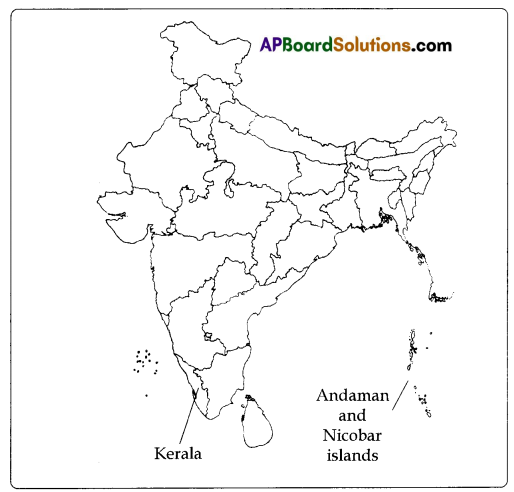
One Mark Questions
Question 1.
What is the another name of shifting cultivation f
Answer:
Podu cultivation.
Question 2.
When did the first forest Att was passed by Indian parliament?
Answer:
2006.
![]()
Question 3.
Which industries need large quantities of pulp wood?
Answer:
Paper industry.
Question 4.
Where is Anaimudi Peak’?
Answer”
Western Ghats.
Question 5.
What do you know about Deciduous forests?
Answer:
Trees shed their leaves.
Question 6.
Which type of sanctuary was established in Srisailam?
Answer:
Tiger sanctuary.
Question 7.
Expand CFM?
Answer:
Community Forest Management.
Question 8.
When did National Forest Policy introduced in India?
Answer:
1988.
Question 9.
Name sonic of the eanipIes of littoral and swamp forests.
Answer:
Uppu ponna, Boddu ponna, Urada and Mada.
Question 10.
Where can we see Evergreen forests in India?
Answer:
Equatorial reg ons or regions like Kerala and Andanian in India.
Objective Type Questions
Question 1.
Most of the forests in the northeastern states belong to the category of ( )
A) Wastelands
B) Protected forests
C) Unclassed forests
D) Mangroves
Answer:
C) Unclassed forests
Question 2.
Which of these statements is not a valid reason for the depletion of flora and fauna? ( )
A) Agricultural expansion
B) Large-scale development project
C) Grazing and fuel wood collection
D) Rapid Industrialisa tion and Urbanication.
Answer:
C) Grazing and fuel wood collection
Question 3.
How have the tribal belts of North-East and Central India been degraded? ( )
A) Overgrazing
B) Shifting cultivation
C) Mining activities
D) None of these
Answer:
B) Shifting cultivation
Question 4.
The forest land that is protected by the forest department from further depletion. ( )
A) Reserved
B) Protected
C) Unclassed
D) Permanent
Answer:
A) Reserved
Question 5.
When did forest suffer the most? ( )
A) During Mughal period
B) During the Colonial period
C) After Independence
D) Alter industrial development
Answer:
B) During the Colonial period
Question 6.
The trees grown in Evergreen forests are ……………. . ( )
A) Kadam
B) Bamboos
C) Jamun
D) All of these
Answer:
B) Bamboos
![]()
Question 7.
Most of the forests of Telangana fall in this category ……………….. . ( )
A) Evergreen
B) Deciduous
C) Thorny
D) Littoral
Answer:
A) Evergreen
Question 8.
………….. trees are not grown in thorny forests? ( )
A) Bulusurega
B) Sandal
C) Urada
D) Neem
Answer:
B) Sandal
Question 9.
……………….. trees are grown in littoral and swamp forests ( )
A) Uppu ponna
B) Boddu ponna
C) Gundu mada
D) All of these
Answer:
D) All of these
Question 10.
Find corred matching ( )
A) Evergreen Forecs – Urada
B) Deciduous forests – Bamboos
C) Thorny forests – Sandal
D) Littoral and swamp forests -Teak
Answer:
Question 11.
This is net true with deciduous forests: ( )
A) Deciduous forests grow where the climate is warm and dry
B) Most of the forest of Telangana fall in dry deciduous forests category
C) Deciduous forests shed their leaves to conserve moisture in dry months
D) Babul, bulusurega, sandal, neem are some of the examples.
Answer:
C) Deciduous forests shed their leaves to conserve moisture in dry months
Question 12.
Thorny forests are in ……………. district. ( )
A) Nalgonda
B) Nizamabad
C) Warangal
D) Adilahad
Answer:
A) Nalgonda
Question 13.
The British government created the forest department in India as per this Act ……………. .( )
A) 1864 Act
B) 1878 Act
C) 1 and 2
D) None of these
Answer:
A) 1864 Act
Question 14.
National forest policy was announced in this year ( )
A) 1985
B) 1986
C) 1987
D) 1988
Answer:
D) 1988
Question 15.
Indian Parliament passed the Forest Rights Act in ………… year. ( )
A) 2005
B) 2006
C) 2007
D) 2008
Answer:
B) 2006
![]()
Question 16.
……………. is an example for coniferous trees ( )
A) Pine
B) Alpine
C) Neem
D) Sandal
Answer:
A) Pine